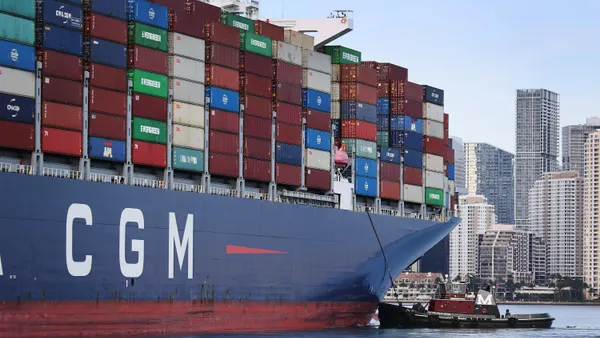Dive Brief:
- Shippers and forwarders need to be prepared for peak season to avoid being “at the mercy of the market,” according to a July 5 report from Xeneta.
- After six months of consecutive double-digit growth in air freight demand, market players are now strategizing how to navigate the expected challenges of Q4 2024 — including higher spot rates.
- “I’ve heard already that certain airlines and forwarders are thinking of implementing a peak season surcharge by the end of August. There’s a consensus it will be a hot Q4 for air cargo in many Asian markets,” Xeneta Chief Airfreight Officer Niall van de Wouw said in the report.
Dive Insight:
Growing e-commerce demand, ocean disruptions due to Red Sea conflicts, and manufacturing activity caused global air cargo spot rates in June to spike 17% year over year to $2.62 per kilogram, according to Xeneta.
YoY growth should continue in the double digits in July and August, van de Wouw said, particularly in comparison to the low demand from last summer.
“The global machine is humming along nicely at this level – but this is likely the calm before the storm in terms of air freight rates,” van de Wouw said.
Despite expectations for strong growth in July and August, van de Wouw noted demand will ease through the balance of Q4 2024 due to "a strong Q4 2023 comparison.”
“Shippers will pay more throughout Q4, the question is how much more?” said van de Wouw.
Southeast Asia to the U.S. recorded the largest spot rate jump of any other corridor, up 14% YoY to $5.32 per kilogram, according to Xeneta. Meanwhile, the Northeast Asia to U.S. corridor experienced a less dramatic increase of 4% YoY to $4.00 per kilogram.
Spot rates from China markets to the U.S. also dipped, albeit by 1% to $4.80 per kilogram.
As uncertainties loom for the air cargo market, shippers are looking to adjust their preferred contract lengths ahead of potentially rocketing rates in the last quarter of the year, Xeneta reported.
In Q2 2024, the share of contracts lasting more than six months grew to 28% as shippers looked to avoid peak season rate fluctuations. According to Xeneta, the dip in three-month contracts “suggests unease among shippers about negotiating rates just before the year-end peak season.”
Van de Wouw said those with long-term capacity agreements will be less at risk for paying high rates. Meanwhile, market players dependent on spot market rates will likely face a “hefty premium.”
“As we head into the second half of the year, it might be now or never to consider longer-term contracts,” Van de Wouw said. “With a mix of ocean shipping chaos, an upturn in manufacturing activities, and fear-of-missing-out, a delicate balance of short and long-term contracts is on everyone's mind. Only time will tell, but whatever happens, you’re going to be paying a lot more to ship goods from Asia Pacific once September comes.”













